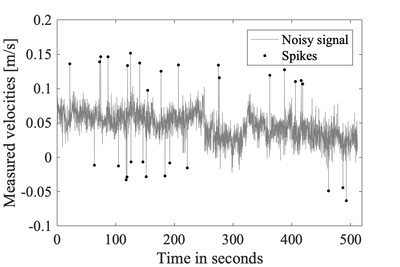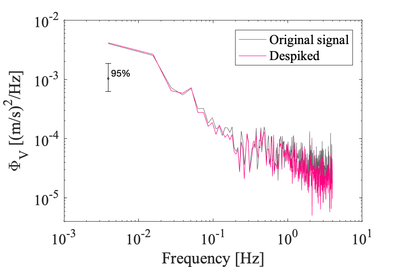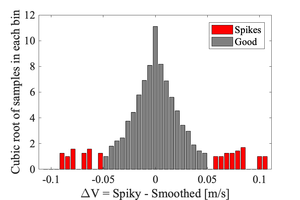Velocity despiking: Difference between revisions
| Line 21: | Line 21: | ||
==Filter based methods== | ==Filter based methods== | ||
This category of methods is quite common in the literature and have been reviewed extensively by others <ref name="GoringNikora"/><ref name="Starkenburg"/>. | This category of methods is quite common in the literature and have been reviewed extensively by others <ref name="GoringNikora"/><ref name="Starkenburg"/>. These methods compare the original signal against a smoothed version, and values exceeding a threshold are deemed to be spikes. Moste commonly, the threshold is applied to the timeseries of the smoothed velocities, substracted from the original spiky signal. | ||
In the 1970s, scientists developed methods based on nonlinear median filters | |||
<ref>{{Cite journal|authors=A.E. Beaton, J.W. Tukey|journal_or_publisher= Technometrics|paper_or_booktitle= The fitting of power series, meaning polynomials, illustrated on band-spectroscopic data | |||
|year= 1974|doi=10.1080/00401706.1974.10489171}}</ref>. | |||
Using a moving median filter is less biased by spikes than other linear opertions such as low-pass butterworth filters. The median filter only requires a window size, i.e, the number of points over which to calculate the median. | |||
Brock (1986)<ref name="Brock"/> proposed a way to determine the threshold using a histrogram of the velocity differences. | |||
[[File:Smoothed velocities.png|thumb|none|400px|Example velocities before and after smoothing (top). Filter-based despiking methods use the difference between these two signals to identify spikes (bottom).]] | [[File:Smoothed velocities.png|thumb|none|400px|Example velocities before and after smoothing (top). Filter-based despiking methods use the difference between these two signals to identify spikes (bottom).]] | ||
Revision as of 23:19, 24 November 2021
Overview
Any measured signal may be contaminated by spikes. These spikes are typically short-lived and transient, which result in sudden change in the measured velocities.
Spikes in velocities measured by acoustic-Doppler velocimeters can result from aliasing of the Doppler signal, in particular when pulses become contaminated by reflecting from complex objects and boundaries [1]. These spikes must be removed because they can alter quite dramatically the velocity spectra, which is then used for fitting inertial subrange model.
-

Example velocities measured by an acoustic-Doppler velocimeters -

Example velocity spectra before and after removing spikes. The variance of the despiked signal has reduced by 12% even though there were 30 spikes
Despiking methods
Several techniques exist for despiking. The most used with acoustic-Doppler velocimeters are the phase-space thresholding techniques [1]. Other techniques currently being investigated by the subgroup are those used in atmospheric turbulence studies [2], in particular the median filter despiking technique [3]. This method derives its threshold for identifying spurious spikes from the dataset.
Filter based methods
This category of methods is quite common in the literature and have been reviewed extensively by others [1][2]. These methods compare the original signal against a smoothed version, and values exceeding a threshold are deemed to be spikes. Moste commonly, the threshold is applied to the timeseries of the smoothed velocities, substracted from the original spiky signal.
In the 1970s, scientists developed methods based on nonlinear median filters
[4].
Using a moving median filter is less biased by spikes than other linear opertions such as low-pass butterworth filters. The median filter only requires a window size, i.e, the number of points over which to calculate the median.
Brock (1986)[3] proposed a way to determine the threshold using a histrogram of the velocity differences.

Identifying the threshold

Phase-space thresholding methods
Elaborate a bit? Or include information in a separate page
Notes
- ↑ Jump up to: 1.0 1.1 1.2 D. G. Goring and V.I. Nikora. 2002. Despiking Acoustic Doppler Velocimeter Data. Journal of Hydraulic Engineering. doi:10.1061/ASCE0733-94292002128:1117
- ↑ Jump up to: 2.0 2.1 D. Starkenburg, S. Metzger, G.J. Fochesatto, J.G Alfieri, R. Gens and A. Prakash and J. Cristobal. 2016. Assessment of Despiking Methods for Turbulence Data in Micrometeorology. J. Atmos. Oceanic Technoly. doi:10.1175/JTECH-D-15-0154.1
- ↑ Jump up to: 3.0 3.1 F.V. Brock. 1986. A nonlinear filter to remove impulse noise from meteorological data. J. Atmos. Oceanic Technoly. doi:10.1175/1520-0426(1986)003,0051:ANFTRI.2.0.CO;2
- ↑ A.E. Beaton and J.W. Tukey. 1974. The fitting of power series, meaning polynomials, illustrated on band-spectroscopic data. Technometrics. doi:10.1080/00401706.1974.10489171
